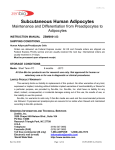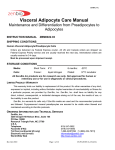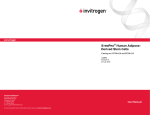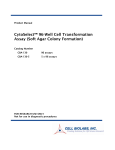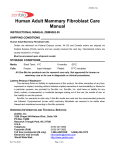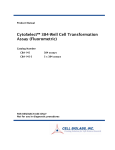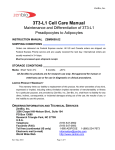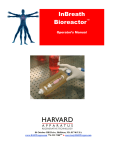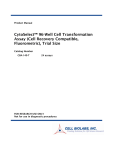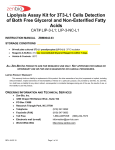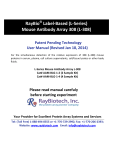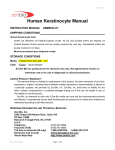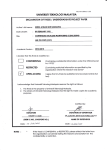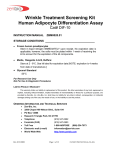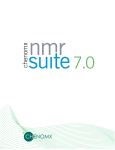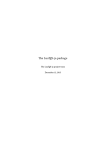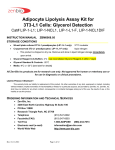Download Human Adult Stem Cell Manual - Zen
Transcript
ZenBio, Inc. Human Adult Stem Cell Manual Differentiation protocols for human adipose-derived adult stem cells INSTRUCTION MANUAL ZBM0015.03 SHIPPING CONDITIONS Human Adult Stem Cells (ASC) Orders are delivered via Federal Express courier. All US and Canada orders are shipped via Federal Express Priority service and are usually received the next day. International orders are usually received in 3-4 days. Must be processed upon shipment receipt. STORAGE CONDITIONS Media: Short Term 4°C 6 months -20°C All Zen-Bio Inc products are for research use only. Not approved for human or veterinary use or for use in diagnostic or clinical procedures. LIMITED PRODUCT WARRANTY This warranty limits our liability to replacement of this product. No other warranties of any kind, expressed or implied, including without limitation implied warranties of merchantability or fitness for a particular purpose, are provided by Zen-Bio, Inc. Zen-Bio, Inc. shall have no liability for any direct, indirect, consequential, or incidental damages arising out of the use, the results of use, or the inability to use this product. Zen-Bio, Inc warrants its cells only if Zen-Bio media are used and the recommended protocols are followed. Cryopreserved adult stem cells are assured to be viable when thawed and maintained according to Zen-Bio protocols. ORDERING INFORMATION AND TECHNICAL SERVICES ZenBio, Inc. 3200 Chapel Hill-Nelson Blvd., Suite 104 PO Box 13888 Research Triangle Park, NC 27709 U.S.A. Telephone (919) 547-0692 Facsimile (FAX) (919) 547-0693 Toll free (continental US only) 1-866-ADIPOSE 1-(866)-234-7673 Electronic mail (e-mail) [email protected] World Wide Web http://www.zenbio.com Rev Oct 2010 Page 1 of 13 US PATENT (6,555,374) ZenBio, Inc. CONTENTS PAGE # Introduction 3 Materials Provided for Each Catalog Item 3 Media Compositions 4 Plating and Expansion of Cryopreserved Adult Stem Cells 5 Adipogenesis Protocol 6 Osteogenesis Protocol 8 Chondrogenesis Protocol 10 Troubleshooting 11 Frequently Asked Questions 12 Pathogen testing 13 Rev Oct 2010 Page 2 of 13 US PATENT (6,555,374) ZenBio, Inc. INTRODUCTION The adipose derived adult stem cells are isolated from subcutaneous adipose tissue of healthy non-diabetic donors between 18 and 60 years old undergoing elective surgery. The cells are isolated by centrifugal force after collagenase treatment. Adult stem cells can be differentiated into various lineages using Zen-Bio media formulations and protocols. This instruction manual describes procedures to induce human adipose derived adult stem cells (ASC) to differentiate into 1) mature adipocytes, 2) osteoblasts, and 3) chondrocytes. The process of differentiating human adipose-tissue derived adult stem cells to adipocytes has been patent protected by Zen-Bio under US patent number 6153432. PRECAUTIONS This product is for research use only. It is not intended for human, veterinary, or in vitro diagnostic use. Proper precautions and biological containment should be taken when handling cells of human origin, due to their potential biohazardous nature. Always wear gloves and work behind a protective screen when handling primary human cells. All media, supplements, and tissue cultureware used in this protocol should be sterile. Human adult stem cell viability depends greatly on the use of suitable media, reagents, and sterile plastic wear. If these parameters are not carefully observed, limited differentiation may occur and cell growth may be slow. MATERIALS PROVIDED FOR EACH CATALOG ITEM Cryopreserved Human Adipose-Derived Adult Stem Cells (catalog # ASC-F) Frozen vial containing either 1.0 or 2.0 x106 viable adult stem cells (store in liquid nitrogen upon receipt) 50 ml Preadipocyte Medium [NOTE: this medium is suitable as a plating medium for the adipose derived adult stem cells] Rev Oct 2010 Page 3 of 13 US PATENT (6,555,374) ZenBio, Inc. MEDIA COMPOSTIONS Preadipocyte Medium cat # PM-1 DMEM / Ham’s F-12 (1:1, v/v) HEPES pH 7.4 Fetal bovine serum Penicillin Streptomycin Amphotericin B Adipocyte Basal Medium Cat# BM-1 Adipocyte Differentiation Medium cat # DM-2 DMEM / Ham’s F-12 (1:1, v/v) HEPES pH 7.4 Fetal bovine serum Biotin Pantothenate Human insulin Dexamethasone Isobutylmethylxanthine PPAR agonist Penicillin Streptomycin Amphotericin B Osteoblast Differentiation Medium Cat# OB-1 DMEM / Ham’s F-12 (1:1, v/v) HEPES pH 7.4 Biotin Pantothenate DMEM / Ham’s F-12 (1:1, v/v) Fetal Bovine serum -glycerophosphate Ascorbate-2-phosphate Dexamethasone 1,25 (OH)2 Vitamin D3 Penicillin Streptomycin Adipocyte Maintenance Medium cat # AM-1 DMEM / Ham’s F-12 (1:1, v/v) HEPES pH 7.4 Fetal bovine serum Biotin Pantothenate Human insulin Dexamethasone Penicillin Streptomycin Amphotericin B Chondrocyte Differentiation Medium Cat# CM-1 DMEM-high glucose Fetal bovine serum Transforming growth factor 1(TGF-1) Ascorbate-2-phosphate Dexamethasone Insulin-transferrin-selenium plus (ITS+) Penicillin Streptomycin NOTE: All media except Chondrocyte Medium contains 3.15g/L (17.5mmol/L) D-glucose. Chondrocyte Differentiation Medium contains 4.5g/L (25.0mmol/L) D-glucose All media are also available as phenol red free and/or without serum. Please inquire for custom media requests. MEDIA EXPIRATION DATES: If placed at 4C upon arrival, the media is stable until the expiration date on the bottle label. If stored at -20C upon arrival, the media is stable for 6 months. Add fresh antibiotics when you are ready to use. The media will expire 30 days after the thaw date. Rev Oct 2010 Page 4 of 13 US PATENT (6,555,374) ZenBio, Inc. PLATING AND EXPANSION PROCEDURES Cryopreserved Adult Stem Cells 1. Remove cells from liquid nitrogen and place immediately into a 37C water bath with agitation. Be careful not to submerge the cap of the vial into water. Do not leave the vials in water bath after most of the content has thawed. Rinse the vials with 70% ethanol before taking them to the culture hood. 2. Upon the thawing, add the cells to a sterile conical bottom centrifuge tube, containing 10 ml of Growth Medium (Preadipocyte Medium (PM-1). 3. Centrifuge at 280 x g, 20C, 5 minutes. Aspirate the medium and resuspend cells in a volume of PM-1 appropriate for counting the cells. Count using a hemacytometer. 4. Place approximately 6.7 X 105 cells in T-75 culture flasks using PM-1. 5. Incubate cells until they are 85-90% confluent (in about 4-5 days). Do not let the cells become 100% confluent (see Figure 1-A, page 8 for picture of 100% confluent cells). Cells will need to be fed every other day with PM-1. 6. Aspirate medium and wash adult stem cells 4-5 times using sterile Phosphate Buffered Saline (PBS) to remove all traces of serum (until there is no foaming of the medium). Remove the PBS and release the cells from the flask bottom by adding 2 mL/T-75 flask (or 6 ml/T-225 flask) of 0.25% trypsin/ 2.21mM EDTA solution. Allow cells to trypsinize for 5 minutes at 37C. Tap the flask gently to loosen the cells. 7. Neutralize the trypsin using 7 ml PM-1 per T-75 flask (or 21 ml per T-225 flask). Check the flask under a microscope to ensure all cells are free of the flask bottom. 8. Count the cells and plate in desired format. Ensure cells are evenly suspended when plating large numbers of plates or flasks. Do not agitate plates and flasks after plating. Place in a humidified incubator at 37C and 5% CO2, making sure the surface is level for even cell distribution. 9. OPTIONAL – Cryopreserve stem cells after counting. Centrifuge at 280 x g, 20C, 5 minutes. Suspend in cold cryopreservation medium (Cat# FM-1-100) at a concentration of 1X106 cells/ml. Do not exceed a 6:1 ratio of cells (per million): volume cryopreservation medium (per ml). Remember to account for the volume of the cell pellet before adding the volume of cryopreservation medium necessary for cell suspension. If using a controlled-rate freezer: Freeze by reducing the temperature 1°C per minute until the temperature reaches -80° C. If using a cell cryopreservation container, prepare according to the manufacturer’s instructions. For best results we recommend transferring the vials to the vapor phase of a liquid nitrogen storage facility as soon as possible after the cells have reached -80°C. Rev Oct 2010 Page 5 of 13 US PATENT (6,555,374) ZenBio, Inc. ADIPOGENESIS PROCEDURE Differentiation of Adult Stem Cells into Adipocytes Please note: Primary cells can be very sensitive to brands of cultureware. Zen-Bio does not currently recommend the use of Falcon or Sarstedt brand plates or flasks. Our scientists are using Nunc, Costar/Corning, or Greiner bio-one CellStar tissue culture treated plates and flasks. Please contact us if you have any questions. 1. Remove cells from liquid nitrogen and place immediately into a 37 C water bath and agitate while in bath. Be careful not to submerge the cap of the vial into water. Do not leave the vials in water bath after most of the content has thawed. Rinse the vials with 70% ethanol before taking them to the culture hood. 2. Upon thawing, transfer the cells to a sterile conical bottom centrifuge tube containing 10 ml of Preadipocyte Medium (cat # PM-1). Centrifuge: 1,200 rpm (282 X g) / 20C / 5 minutes. Aspirate the supernatant. TAKE CARE TO NOT ASPIRATE ANY OF THE CELL PELLET. 3. The cell vial contains a minimum of 1.0 or 2.0 x 106 viable cells; however, we recommend performing a cell count to determine a more exact number of cells. Resuspend the cell pellet in 2 ml Preadipocyte medium; dilute an aliquot in 0.4% trypan blue solution. We suggest withdrawing an aliquot of 50 l of cells and mixing with 100 l of the trypan blue solution, resulting in a dilution factor of 3. Count live (unstained) cells on a hemacytometer. 4. Plate approximately 40,625 cells / cm2 using the media volumes from the table below. Refer to the manufacturer’s specifications for the specific cultureware brand you are using. FORMAT VOLUME PER WELL 96 well plate 48 well plate 24 well plate 12 well plate 6 well plate 10 cm dish T-75 flask T25 flask 150 l 500 l 1 ml 2 ml 3 ml 15 ml 20 ml 7 ml TOTAL VOLUME PER FORMAT* 14.4 ml 24.0 ml 24.0 ml 24.0 ml 18.0 ml 15.0 ml 20.0 ml 7.0 ml *We recommend preparing slightly larger volumes to allow for loss due to foam and pipet error. 5. Plate cells in desired format and place in a humidified 37oC incubator with 5% CO2. Do not agitate the plate, as cells will not plate evenly. 6. Twenty-four hours after plating, check the plates for confluence. If they are not completely confluent, leave for and additional 24 hours maximum before inducing differentiation. If the cells are not confluent after 48 hours, DO NOT INDUCE DIFFERENTIATION (differentiation will be poor). Contact Zen-Bio immediately. Rev Oct 2010 Page 6 of 13 US PATENT (6,555,374) ZenBio, Inc. 7. To start the process, aspirate the entire volume of Preadipocyte Medium from all wells. Add the appropriate volume of Adipocyte Differentiation Medium (catalog # DM-2) to the wells (see Table 1. Feeding Volumes). Incubate plate for 7 days at 370C and 5% CO2. 8. After 7 days, cells should be fed by removing some of the media and replacing with fresh Adipocyte Medium (catalog # AM-1) (See Table 1. Feeding Volumes). Caution: Do not dry the wells. Add new medium gently. If using an automatic feeder, set the slowest flow rate possible. 9. Two (2) weeks after the initiation of differentiation, cells should appear rounded with large lipid droplets apparent in the cytoplasm (see Figure 1-C). Cells are now considered mature adipocytes and are suitable for most assays. Table 1. Adipogenesis: Feeding Volumes Format Plating Change PM-1 to DM-2 Change DM-2 to AM-1 Change AM-1 to AM-1 IN OUT IN OUT IN OUT IN 96 well plate 150 l/well 150 l/well 150 l/ well 90 l/well 120 l/well 90 l/well 90 l/well 48 well plate 500 l/well 500 l/well 500 l/well 300 l/well 400 l/well 300 l/well 300 l/well 24 well plate 1.0 ml/well 1.0 ml/well 1.0 ml/well 0.6 ml/well 0.8 ml/well 0.6 ml/well 0.6 ml/well 12 well plate 2.0 ml/well 2.0 ml/well 2.0 ml/well 1.2 ml/well 1.6 ml/well 1.2 ml/well 1.2 ml/well 6 well plate 3.0 ml/well 3.0 ml/well 3.0 ml/well 1.8 ml/well 2.4 ml/well 1.8 ml/well 1.8 ml/well T-75 flask 20 ml/flask 20 ml/flask 20 ml/flask 12 ml/flask 16 ml/flask 12 ml/flask 12 ml/flask T-25 flask 7 ml/flask 7 ml/flask 7 ml/flask 4.2 ml/flask 5.6 ml/flask 4.2 ml/flask 4.2 ml/flask A. 100% Confluent Adult stem cells B. 1-week-old adipocytes (1 wk post-differentiation) C. 2-week-old adipocytes (2 wks post-differentiation) PREADIPOCYTE MATURE ADIPOCYTE nucleus Lipid droplets nucleus Figure 1: Photographs of 100% confluent Adult stem cells (ASC) (A), 1-week-old (post-differentiation) cultured adipocytes (B) and mature (2 weeks post-differentiation) cultured Adipocytes (C). These are unstained photographs of human adult stem cell morphology (20X). The cells should appear comparable in appearance to these pictures. Rev Oct 2010 Page 7 of 13 US PATENT (6,555,374) ZenBio, Inc. OSTEOGENESIS PROCEDURE Differentiation of Adult Stem Cells into Osteoblasts 1. Remove cells from liquid nitrogen and place immediately into a 37 C water bath and agitate while in bath. Be careful not to submerge the cap of the vial into water. Do not leave the vials in water bath after most of the content has thawed. Rinse the vials with 70% ethanol before taking them to the culture hood. 2. Upon thawing, transfer the cells to a sterile conical bottom centrifuge tube containing 10 ml of Preadipocyte Medium (cat # PM-1). Centrifuge: 1,200 rpm (282 X g) / 20C / 5 minutes. Aspirate the supernatant. TAKE CARE TO NOT ASPIRATE ANY OF THE CELL PELLET. 3. The cell vial contains a minimum of 1.0 or 2.0 x 106 viable cells; however, we recommend performing a cell count to determine a more exact number of cells. Resuspend the cell pellet in 2 ml Preadipocyte medium; dilute an aliquot in 0.4% trypan blue solution. We suggest withdrawing an aliquot of 50 l of cells and mixing with 100 l of the trypan blue solution, resulting in a dilution factor of 3. Count live (unstained) cells on a hemacytometer. 4. Plate approximately 30,000 cells / cm2 using the media volumes from the table below. Refer to the manufacturer’s specifications for the specific cultureware brand you are using. FORMAT VOLUME PER WELL 96 well plate 48 well plate 24 well plate 12 well plate 6 well plate 10 cm dish T-75 flask T25 flask 150 l 500 l 1 ml 2 ml 3 ml 15 ml 20 ml 7 ml TOTAL VOLUME PER FORMAT 15 ml /plate 24ml/plate 25ml/plate 25ml/plate 18 ml/plate 15ml/dish 20 ml/flask 7 ml/ flask NUMBER CELLS PER FORMAT 0.93 X 106 cells/15 ml 1.25 X 106 cells/25 ml 1.44X 106 cells/26ml 1.5 X 106 cells/26ml 1.8 X 106 cells/20ml 2.25 X 106 cells/15 ml 2.25 X 106 cells/20ml 0.75 X 106 cells/7ml *We recommend preparing slightly larger volumes to allow for loss due to foam and pipet error. 5. Plate cells in desired format and place in a humidified 37oC incubator with 5% CO2. Do not agitate the plate, as cells will not plate evenly. 6. Twenty-four hours after plating, aspirate the entire volume of Preadipocyte Medium from all wells. Add the appropriate volume of Osteoblast Differentiation Medium (catalog # OB-1) to the wells (see Table 3. Osteogenesis Feeding Volumes). 7. Incubate cells at 370C and 5% CO2. 8. Feed cells every 3 days with Osteoblast Differentiation Medium (catalog # OB-1). Rev Oct 2010 Page 8 of 13 US PATENT (6,555,374) ZenBio, Inc. Table 3. Osteogenesis Feeding Volumes Format Volume per well 96 well plate 150 l/well 48 well plate 24 well plate 12 well plate 6 well plate T-75 flask T-25 flask 300 l/well 1.0 ml/well 2.0 ml/well 3.0 ml/well 12 ml/flask 7 ml/flask Figure 2. Osteoblasts, (20X) Alizarin red staining of 14 day old cells shows significant mineralization. Rev Oct 2010 Page 9 of 13 US PATENT (6,555,374) ZenBio, Inc. CHONDROGENESIS PROCEDURE Differentiation of Adult Stem Cells into Chondrocytes 1. Remove cells from liquid nitrogen and place immediately into a 37 C water bath and agitate while in bath. Be careful not to submerge the cap of the vial into water. Do not leave the vials in water bath after most of the content has thawed. Rinse the vials with 70% ethanol before taking them to the culture hood. 2. Upon thawing, transfer the cells to a sterile conical bottom centrifuge tube containing 10 ml of Preadipocyte Medium (cat # PM-1). Centrifuge: 1,200 rpm (282 X g) / 20C / 5 minutes. Aspirate the supernatant. TAKE CARE TO NOT ASPIRATE ANY OF THE CELL PELLET. 3. The cell vial contains a minimum of 1.0 or 2.0 x 106 viable cells; however, we recommend performing a cell count to determine a more exact number of cells. Resuspend the cell pellet in 2 ml Preadipocyte medium (PM-1), dilute an aliquot in 0.4% trypan blue solution. We suggest withdrawing an aliquot of 50 l of cells and mixing with 100 l of the trypan blue solution, resulting in a dilution factor of 3. Count live (unstained) cells on a hemacytometer. 4. Remove the supernatant and resuspend the cell pellet in 1.2 % alginate solution (made in 150mM NaCl) at 4 x 106 cells/ml. Pipette up and down without creating bubbles to mix thoroughly. 5. Draw the cell-seeded alginate suspension into a sterile 10 cc syringe using a 22 gauge needle. 6. Add 3 ml of CaCl2 (102 mM) into one well of a 6 well culture plate. 7. Carefully and slowly dispense equal-sized droplets of the cell-seeded alginate solution into the CaCl2 solution (dispense10-30 beads per well taking care to avoid clumping the beads). Cure the beads in the CaCl2 solution for 10 minutes at room temperature. 8. Using a glass pipette, aspirate the CaCl2 solution off the beads. Be careful not to aspirate the beads with the solution. 9. Wash the cell-seeded alginate beads three times with NaCl (150 mM) and then one more time with DMEM-HG. 10. Add 3 ml of the Chondrogenic Differentiation Medium (cat# CM-1). 11. Incubate at 37°C, 5.0 % CO2, and 95% relative humidity for the duration of the experiment. 12. Change media every three days. Figure 3. Differentiated cells stained for collagen production. Rev Oct 2010 Page 10 of 13 US PATENT (6,555,374) ZenBio, Inc. TROUBLESHOOTING GUIDE Observation Adult stem cells do not differentiate Possible causes 1. Cells have been passaged too many times 1. Use cells of a lower passage number 2. Differentiation conditions not optimal 2. Use our defined differentiation medium. 3. Cells were plated at a low density 3. Use the cell density recommended in our manual 4. Cultureware used not optimal for human primary adipocytes 4. Zen-Bio does not recommend the use of Falcon or Sarstedt brand cultureware for all Adipogenesis cell culture applications 5. Differences in cultureware 5. Verify the surface area for the cultureware brand you are using. brand surface area may affect plating density in unknown Adult stem cells do not grow Edge effects Adipogenesis: Adipocytes appear uneven in each well Suggestions 1. Cells have been passaged too many times 2. Cells expanded too high 3. Cultureware used not optimal for human primary adult stem cells 1. Medium in outside wells evaporated 1. Use cells of a lower passage number 2. Do not exceed 1:6 expansion ratio 3. Use only Costar, Nunc or Greiner cultureware 1. Medium was completely removed during feeding 1. Make sure to follow instructions listed in Table 1 Feeding Volumes 2. Fresh medium was added too quickly 2. Add media slowly to each well. Position the pipet tips halfway down, pressing on the side of the wells and slowly release the medium. 3. Cells placed on uneven surface in the incubator 1. Ensure a saturated humidity in the incubator. Make sure multiple plates are stacked no more than 3 plates high. 3. Place cultureware are on a level surface in the incubator to ensure cells attach evenly. Rev Oct 2010 Page 11 of 13 US PATENT (6,555,374) ZenBio, Inc. FREQUENTLY ASKED QUESTIONS Can I pass the cells? Adult Stem Cells can be trypsinized and replated several times. They grow slower with each passage and undergo adipogenesis poorly after passage 4. All cells are shipped at Passage 2-3. How fast do the cells replicate? The average doubling time is 48-84 hours. However, keep in mind that the replication rate for human adult stem cells varies slightly from donor to donor. Should antibiotics be included in the medium? Yes. Antibiotics and anti-fungal agents are always recommended since the cells are primary cells. All Zen-Bio media contain antibiotics and/or anti-fungal agents except Adipocyte Basal Medium (cat# BM-1). Where are the cells obtained? The adult stem cells are isolated from human subcutaneous adipose tissue. Do you test for pathogens? Which ones? Yes. Samples from each donor are tested via PCR to confirm non-reactivity for HIV-1, HIV-2, HTLV I, HTLV II, hepatitis B and hepatitis C. However, since we cannot test all pathogens, please treat the culture as a potentially infectious agent. How do I obtain RNA from the cells? How much RNA can I expect? Use RNA Tri-reagent (Molecular Products), RNeasy kit (Qiagen), or a guanidine thiocyanate solution (Chomzynski protocol). You can expect approximately 20 g total RNA from a 10 cm dish of adult stem cells. What donor information do I receive? The donor’s age, gender, and BMI are provided in the certificate of analysis that accompanies each lot of cells. What is the formulation of Zen-Bio’s serum-free media? Zen-Bio’s serum-free media are not enhanced to supplement the absence of serum. These media are available for assay procedures where cells are rested from serum. Do not differentiate adult stem cells into adipocytes using medium without serum. What quality control testing is conducted on the cells? We do confirm the presence of several cell surface markers indicative of stem cells via flow cytometry. The adult stem cells stain >99% positive for CD105 and CD44; negative for CD31 and CD45. Our quality control for adipocytes is lipid staining, total triglyceride content, and functional lipolysis; for osteoblasts it is measurement of degree of mineralization as assessed by Alizarin Red staining; for chondrocytes it is collagen staining. Rev Oct 2010 Page 12 of 13 US PATENT (6,555,374) ZenBio, Inc. Can the adult stem cells be differentiated into any additional cell types? Other researchers have differentiated adult stem cells into smooth muscle, neuronal, and hepatocyte lineages. See selected references below. Mizuno, et al. Myogenic differentiation by human processed lipoaspirate cells. Plastic and Reconstructive Surgery (2002) 109:199-209. Seo, et al. Differentiation of human adipose stromal cells into hepatic lineage in vitro and in vivo. Biochem Biophys. Res. Comm. (2005) 328: 258-264. Rodríguez, RV, et al. Clonogenic multipotent stem cells in human adipose tissue differentiate into functional smooth muscle cells. Proc Natl Acad Sci USA. (2006), 103(32): 12167–12172. Wouter, JFM et al. Effect of tissue-harvesting site on yield of stem cells derived from adipose tissue: implications for cell-based therapies. Cell Tissue Res. (2008) 332(3): 415–426. PATHOGEN TESTING Samples from each donor are tested via PCR to confirm non-reactivity for HIV-1, HIV-2, HTLV I, HTLV II, hepatitis B and hepatitis C. However, no known test can offer complete assurance that the cells are pathogen free. Our products are tested and are free from mycoplasma contamination. Proper precautions and biological containment should be taken when handling cells of human origin, due to their potential biohazardous nature. All human based products should be handled at a BSL-2 (Biosafety Level 2) or higher. Always wear gloves and work behind a protective screen when handling primary human cells. Rev Oct 2010 Page 13 of 13 US PATENT (6,555,374)













